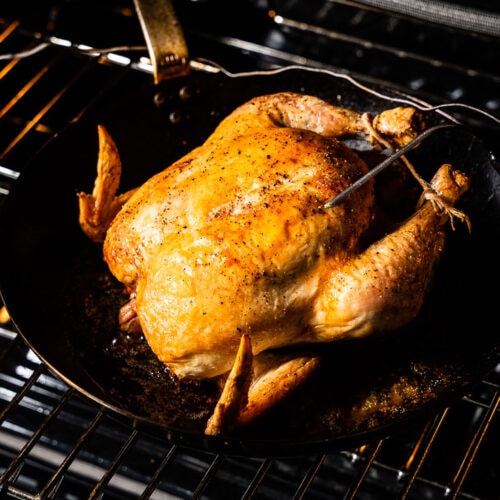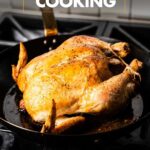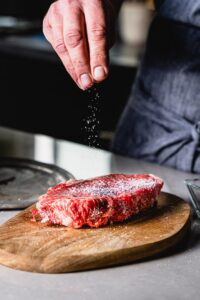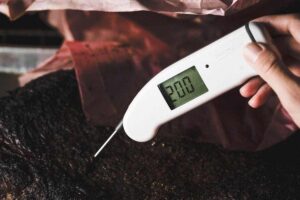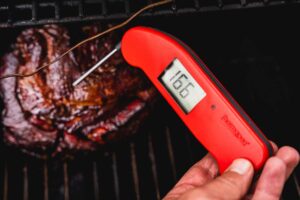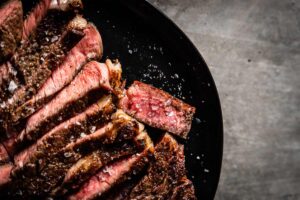Do you ever wonder why your meat turned out overcooked when you cooked it to the exact temperature you intended? The reason is most likely because of carryover cooking.
When you cook a large piece of meat, the temperature will continue to rise after you remove it from the heat source (the oven or smoker), which is called carryover cooking. If you don’t pull the meat earlier than the desired finished internal temperature, then it will be cooked more than you were going for (aka, overcooked). It’s like driving a car and approaching a stop sign. If you don’t take your foot off the accelerator and start coasting, you’ll go right through the stop sign.
What is Carryover Cooking?
Carryover cooking is the phenomenon where the temperature of your food continues to rise after it is removed from the heat source. This happens because there is residual heat that will continue to infiltrate the cooler inner parts of the food, thus causing the temperature to rise.
If your chicken is precisely 165°F in the thickest part of the breasts when you remove it from the heat source, you might think it’s perfectly cooked. However, the bad news is that it’s actually going to finish around 170-175°F after it rests, and will start to become dry and tough.
The amount of carryover cooking or temperature rise depends on a few factors, including the temperature of the heat source, the size, and the thickness of the food. The rise can be just a few degrees for a small dish cooked in a lower-temperature oven and can be as large as 10 to 15 degrees when cooking something like a large rib roast or a turkey in a hot oven.
We must plan for this and remove the food from the heat source before it reaches the doneness we want so it does not overcook. So the “pull temperature” when you actually remove the food from heat is going to be different from the target “finished temperature.”
Factors that Affect the Carryover Amount
There are a few key factors that influence how much the temperature will rise after the food is removed from the heat source.
The Size and Shape of the Meat
Small cuts of meat, like steaks or pork chops, might only rise a few degrees, while a large, thick roast might climb as much as 10+ degrees. The larger the mass of the meat, the more residual heat it retains, and the more the interior temperature will continue to rise.
The Temperature it is Cooked At
Low and slow cooking methods, like smoking a brisket or braising, result in less carryover cooking compared to hot and fast cooking methods like roasting or grilling. When cooking at a low temperature, the heat has more time to evenly distribute throughout the food, resulting in a smaller temperature gradient between the exterior and interior. This means there is less residual heat left to cause carryover cooking.
The Type of Meat
Just because a cut of meat is the same size and shape, doesn’t mean it will be the same either. Beef and pork will be quite a bit different because of how the actual meat is made up and the fat content within it. Also, different types of fish and seafood will cook quite differently.
Because of all these factors, it’s really difficult to know how much the particular piece of food you are cooking is going to carry over. It’s always best to use a leave-in meat thermometer and monitor the internal temp after it fully rests. It is also a reason that much more precise cooking methods like the sous vide technique and reverse sear have become so popular.
Carryover Cooking Examples
Below are some examples of what carryover cooking amounts might be based on the cut of meat. With all the variables of cooking involved, it’s virtually impossible to list out all the potential scenarios, but this will give you an idea of the ranges.
| Cut | Approx. Carryover Temp Rise |
|---|---|
| Beef Rib Roast | 10-15° F |
| Pork Loin | 5-10° F |
| Whole Chicken | 5-10° F |
| Chicken Breasts | 5-7° F |
| Whole Turkey | 5-12° F |
| Steak / Pork Chops (1-inch thick) | 5-7° F |
| Leg of Lamb | 5-10° F |
*These are general ranges and can be affected by factors like the starting temperature of the meat, cooking temperature, and the size and shape of the cut. Always use a meat thermometer to ensure safe internal temperatures.
Exceptions
When cooking something with the sous vide method, there will be no carryover cooking because the food is cooked in a water bath at the precise target temperature. There is no way for it to rise above that.
The reverse sear cooking method has very minimal carryover temperature rise because of the low initial cooking temperatures. In both of these methods, the temperature of the heat source is close to the target temperature of the food, and not significantly above it like in a 400°+ F oven.
Summary
The big point here is that you need to remove the meat from the heat source well before it reaches the desired finished temperature to account for carryover cooking.
- Higher cooking temperatures generally lead to greater carryover.
- Thicker cuts of meat will have more carryover than thinner cuts.
- Tenting roasted meats loosely with foil during resting can help trap heat and promote some additional carryover.
Accounting for the carryover and being off by a few degrees is much better than being off by 10 or 15 degrees when it is ignored. Always cook to temperature (rather than by time) and give it your best estimate for a pull temp with the carryover in mind based on this information.
With experience and a little practice, you will get a good feel for when you should be removing the food from the oven or smoker depending on its mass and the temperature you cooked it at.

